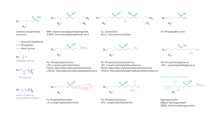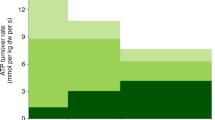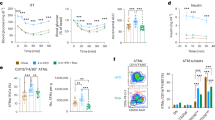Abstract
Cold exposure may be a potential therapy for diabetes by increasing brown adipose tissue (BAT) mass and activity. Here we report that 10 d of cold acclimation (14–15 °C) increased peripheral insulin sensitivity by ∼43% in eight type 2 diabetes subjects. Basal skeletal muscle GLUT4 translocation markedly increased, without effects on insulin signaling or AMP-activated protein kinase (AMPK) activation and only a minor increase in BAT glucose uptake.
This is a preview of subscription content, access via your institution
Access options
Subscribe to this journal
Receive 12 print issues and online access
$209.00 per year
only $17.42 per issue
Buy this article
- Purchase on Springer Link
- Instant access to full article PDF
Prices may be subject to local taxes which are calculated during checkout


Similar content being viewed by others
References
van Marken Lichtenbelt, W.D. et al. N. Engl. J. Med. 360, 1500–1508 (2009).
Virtanen, K.A. et al. N. Engl. J. Med. 360, 1518–1525 (2009).
Cypess, A.M. et al. N. Engl. J. Med. 360, 1509–1517 (2009).
Bartelt, A. et al. Nat. Med. 17, 200–205 (2011).
Stanford, K.I. et al. J. Clin. Invest. 123, 215–223 (2013).
Townsend, K.L. & Tseng, Y.H. Trends Endocrinol. Metab. 25, 168–177 (2014).
van der Lans, A.A. et al. J. Clin. Invest. 123, 3395–3403 (2013).
Yoneshiro, T. et al. J. Clin. Invest. 123, 3404–3408 (2013).
Blondin, D.P. et al. J. Clin. Endocrinol. Metab. 99, E438–E446 (2014).
Ouellet, V. et al. J. Clin. Invest. 122, 545–552 (2012).
Yoneshiro, T. et al. Obesity (Silver Spring) 19, 13–16 (2011).
Hanssen, M.J. et al. Diabetologia 58, 586–595 (2015).
Meex, R.C. et al. Diabetes 59, 572–579 (2010).
Storlien, L., Oakes, N.D. & Kelley, D.E. Proc. Nutr. Soc. 63, 363–368 (2004).
Galgani, J.E. et al. Diabetes 57, 841–845 (2008).
Schrauwen-Hinderling, V.B. et al. Diabetologia 50, 113–120 (2007).
Bal, N.C. et al. Nat. Med. 18, 1575–1579 (2012).
Ruderman, N.B., Carling, D., Prentki, M. & Cacicedo, J.M. J. Clin. Invest. 123, 2764–2772 (2013).
Sato, M. et al. Diabetes 63, 4115–4129 (2014).
Wang, G.X. et al. Nat. Med. 20, 1436–1443 (2014).
Bergström, J., Hultman, E. & Roch-Norlund, A.E. Scand. J. Clin. Lab. Invest. 29, 231–236 (1972).
Vosselman, M.J. et al. Diabetes 61, 3106–3113 (2012).
Vosselman, M.J. et al. Am. J. Clin. Nutr. 98, 57–64 (2013).
DeFronzo, R.A., Tobin, J.D. & Andres, R. Am. J. Physiol. 237, E214–E223 (1979).
Steele, R. Ann. NY Acad. Sci. 82, 420–430 (1959).
Phielix, E. & Mensink, M. Physiol. Behav. 94, 252–258 (2008).
Frayn, K.N. J. Appl. Physiol. 55, 628–634 (1983).
Bolstad, B.M., Irizarry, R.A., Astrand, M. & Speed, T.P. Bioinformatics 19, 185–193 (2003).
Irizarry, R.A. et al. Nucleic Acids Res. 31, e15 (2003).
Dai, M. et al. Nucleic Acids Res. 33, e175 (2005).
Sartor, M.A. et al. BMC Bioinformatics 7, 538 (2006).
Phielix, E. et al. Diabetes 57, 2943–2949 (2008).
Hoeks, J. et al. Diabetes 59, 2117–2125 (2010).
Koopman, R., Schaart, G. & Hesselink, M.K. Histochem. Cell Biol. 116, 63–68 (2001).
Acknowledgements
We thank K. Jardon, E. Broeders, D. Van Moorsel, K. Jansen, M. Visser, R. Hensgens and R. Wierts (Maastricht University Medical Center) for assistance during the experiments and H. Aydeniz, E. Kornips, J. Stegen, W. Sluijsmans, L. Donselaar (Maastricht University Medical Center), W. Wickenhagen (VU University Medical Center Amsterdam) and M. Ackermans (Academic Medical Center Amsterdam) for assistance with the biochemical analyses. The technical support of P. Schoffelen, L. Wouters and M. Souren (Maastricht University Medical Center) is highly appreciated. This work was supported by the EU FP7 project DIABAT (HEALTH-F2-2011-278373 to W.D.v.M.L.) and by the Netherlands Organization for Scientific Research (NWO) (TOP 91209037 to W.D.v.M.L). J.H. is supported by an NWO Vidi grant for innovative research (grant 917.14.358).
Author information
Authors and Affiliations
Contributions
M.J.W.H. was responsible for study design, data acquisition and data analysis and wrote the manuscript. J.H. contributed to the study design, data acquisition and data analysis. B.B. contributed to data analysis. A.A.J.J.v.d.L. contributed to the study design and data acquisition. J.J.v.d.D., M.V.B., M.K.C.H. and S.K. contributed to data acquisition and data analysis. G.S., J.A.J. and B.H. contributed to data acquisition. F.M.M., W.D.v.M.L. and P.S. contributed to the study design and interpretation of data. All authors contributed to the critical revision of the manuscript and approved the final version.
Corresponding author
Ethics declarations
Competing interests
The authors declare no competing financial interests.
Supplementary information
Supplementary Text and Figures
Supplementary Figures 1–2 & Supplementary Tables 1–4 (PDF 863 kb)
Rights and permissions
About this article
Cite this article
Hanssen, M., Hoeks, J., Brans, B. et al. Short-term cold acclimation improves insulin sensitivity in patients with type 2 diabetes mellitus. Nat Med 21, 863–865 (2015). https://doi.org/10.1038/nm.3891
Received:
Accepted:
Published:
Issue Date:
DOI: https://doi.org/10.1038/nm.3891
This article is cited by
-
Deep learning enables the quantification of browning capacity of human adipose samples
Journal of Big Data (2024)
-
Fructose-induced FGF21 secretion does not activate brown adipose tissue in Japanese young men: randomized cross-over and randomized controlled trials
Journal of Physiological Anthropology (2024)
-
M2 macrophages independently promote beige adipogenesis via blocking adipocyte Ets1
Nature Communications (2024)
-
Effects of swimming training in hot and cold temperatures combined with cinnamon supplementation on HbA1C levels, TBC1D1, and TBC1D4 in diabetic rats
Nutrition & Diabetes (2024)
-
Depletion of JunB increases adipocyte thermogenic capacity and ameliorates diet-induced insulin resistance
Nature Metabolism (2024)



